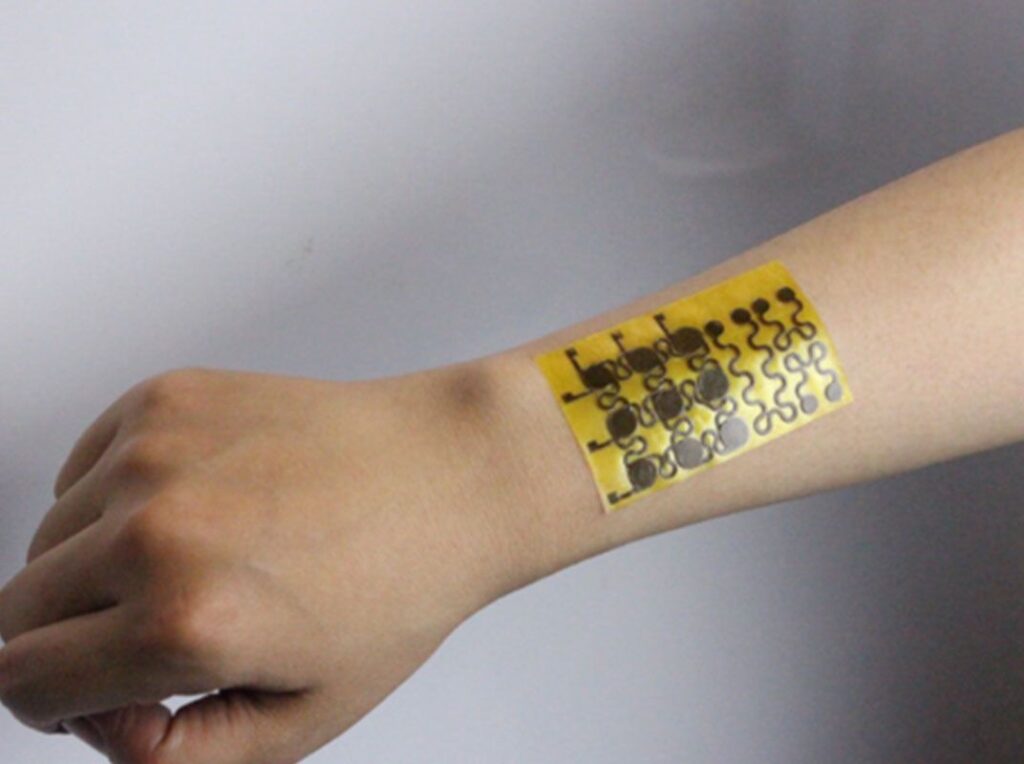Imagine a world where your skin is not just a protective barrier, but a sophisticated interface that can sense your environment, monitor your health, and even communicate with other devices. This is the promise of e-skin, a new generation of electronic skin that is rapidly advancing from science fiction to reality.
What is E-skin?
E-skin is a thin, flexible, and stretchable material that is embedded with electronic components, such as sensors, actuators, and transistors. These components allow e-skin to mimic the functions of human skin, such as sensing pressure, temperature, and strain. E-skin can also be used to deliver electrical stimulation to the skin, which can be used for therapeutic purposes or to control external devices.
The Potential of E-skin
E-skin has the potential to revolutionize a wide range of industries, including healthcare, robotics, and consumer electronics. In healthcare, e-skin could be used to monitor vital signs, such as heart rate and blood pressure, continuously and non-invasively. E-skin could also be used to deliver medication, monitor wound healing, and even provide personalized rehabilitation therapy.
In robotics, e-skin could be used to give robots a sense of touch, allowing them to interact with the world around them in a more natural and human-like way. E-skin could also be used to improve the control of prosthetic limbs and other wearable devices.
In consumer electronics, e-skin could be used to create new and innovative wearable devices, such as smartwatches that can monitor your health in real-time or clothing that can adapt to your environment. E-skin could also be used to create interactive surfaces, such as walls that can respond to your touch or clothing that can change color or pattern.
The Challenges of E-skin
Despite the enormous potential of e-skin, there are still some challenges that need to be overcome before e-skin can be widely adopted. One challenge is developing materials that are both flexible and durable enough to withstand the rigors of everyday use. Another challenge is developing sensors that are sensitive and accurate enough to provide meaningful data.
The Future of E-skin
Despite the challenges, researchers are confident that e-skin will eventually become a reality. In the next few years, we can expect to see e-skin prototypes being tested in a variety of applications. And within the next decade, we may see e-skin devices becoming commercially available.

Photo taken from Smithsonian Magazine.
E-skin has the potential to change the way we live, work, and interact with the world around us. It is a technology that is worth watching closely, as it has the potential to revolutionize our lives in ways we can only begin to imagine.
The History of E-skin
The concept of e-skin has been around for decades, but it was not until the recent advances in materials science and nanotechnology that it became possible to create e-skin that is both flexible and functional.
One of the first pioneers of e-skin was Stanford University professor Zhenan Bao. In 2011, Bao and her team developed a type of e-skin that could self-heal, which was a major breakthrough in the field.
Since then, there has been an explosion of research and development in e-skin. Researchers are now developing e-skin that can sense a wide range of stimuli, including pressure, temperature, strain, and chemicals. They are also developing e-skin that can be used to deliver electrical stimulation, which has the potential to be used for therapeutic purposes or to control external devices.
The Applications of E-skin
E-skin has a wide range of potential applications, including:
- Healthcare: Monitoring vital signs, delivering medication, monitoring wound healing, providing personalized rehabilitation therapy
- Robotics: Giving robots a sense of touch, improving the control of prosthetic limbs
- Consumer electronics: Creating new and innovative wearable devices, creating interactive surfaces
A New Era of Human-Machine Interaction
The advent of e-skin promises to usher in a new era of human-machine interaction, where the boundaries between humans and technology blur. E-skin, with its ability to seamlessly integrate with our bodies, will enable a level of connection with devices that was previously unimaginable. Imagine clothing that can adapt to your environment, providing warmth or ventilation as needed. Or consider prosthetic limbs that can feel sensations, restoring a sense of touch and enhancing the wearer’s interaction with the world.
Personalized Healthcare and Wellness Monitoring
E-skin will revolutionize healthcare, enabling continuous and non-intrusive monitoring of vital signs, such as heart rate, blood pressure, and blood glucose levels. This real-time data will empower individuals to take control of their health, providing early detection of potential health issues and facilitating personalized treatment plans. E-skin could also be used to deliver medication directly to the skin, eliminating the need for invasive injections.
Augmenting Human Capabilities
E-skin has the potential to augment human capabilities, providing enhanced sensory perception and control over external devices. Imagine wearing gloves that can amplify your sense of touch, allowing you to feel the texture of delicate objects with precision. Or consider smart glasses that can overlay digital information onto your field of view, providing real-time navigation assistance or augmenting your learning experience.
Challenges and Considerations
As with any emerging technology, e-skin faces challenges that need to be addressed before it can be widely adopted. One key challenge is developing materials that are both flexible and durable enough to withstand the rigors of everyday use. Another challenge is ensuring the biocompatibility of e-skin materials, minimizing the risk of skin irritation or allergic reactions. Additionally, privacy and security concerns need to be addressed to ensure that e-skin data is protected from unauthorized access.
Conclusion
E-skin represents a transformative leap in the realm of wearable technology, promising to revolutionize healthcare, enhance human capabilities, and redefine our interactions with the world around us. While challenges remain, the potential benefits of e-skin are undeniable. As research and development continue, we can expect to witness the emergence of e-skin devices that seamlessly integrate with our lives, blurring the boundaries between humans and technology and ushering in a new era of human-machine harmony.




